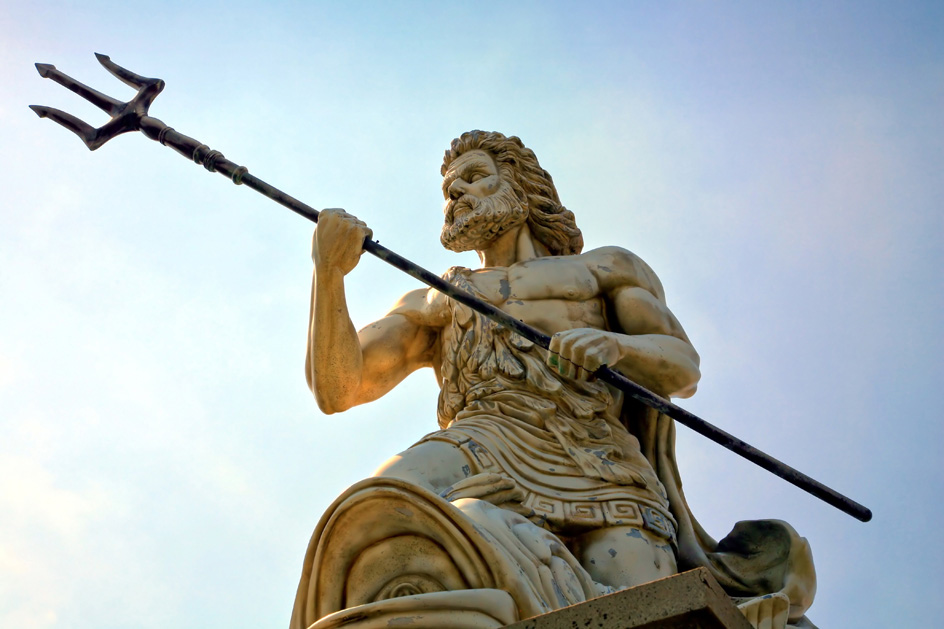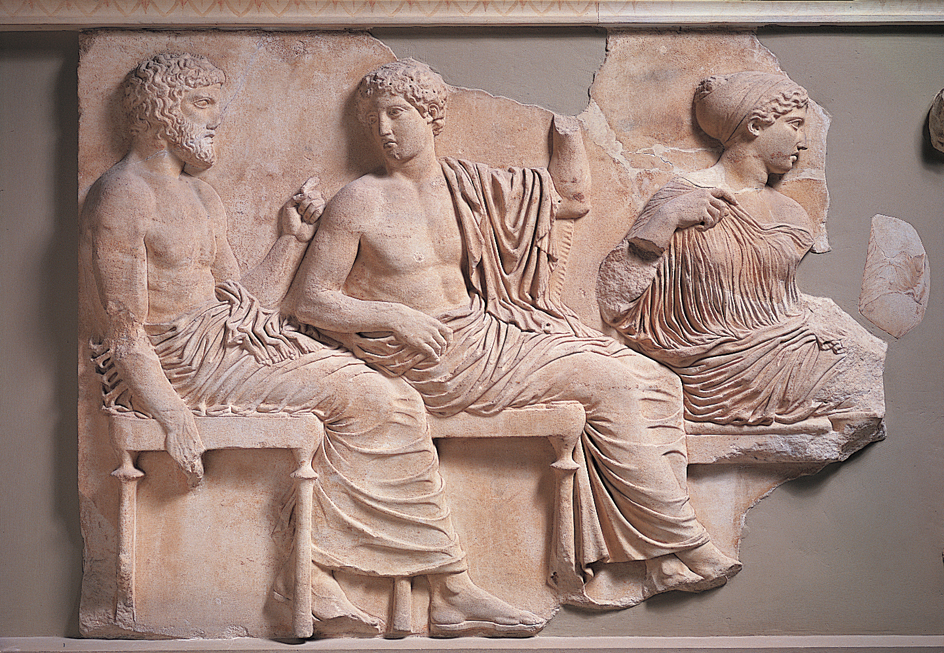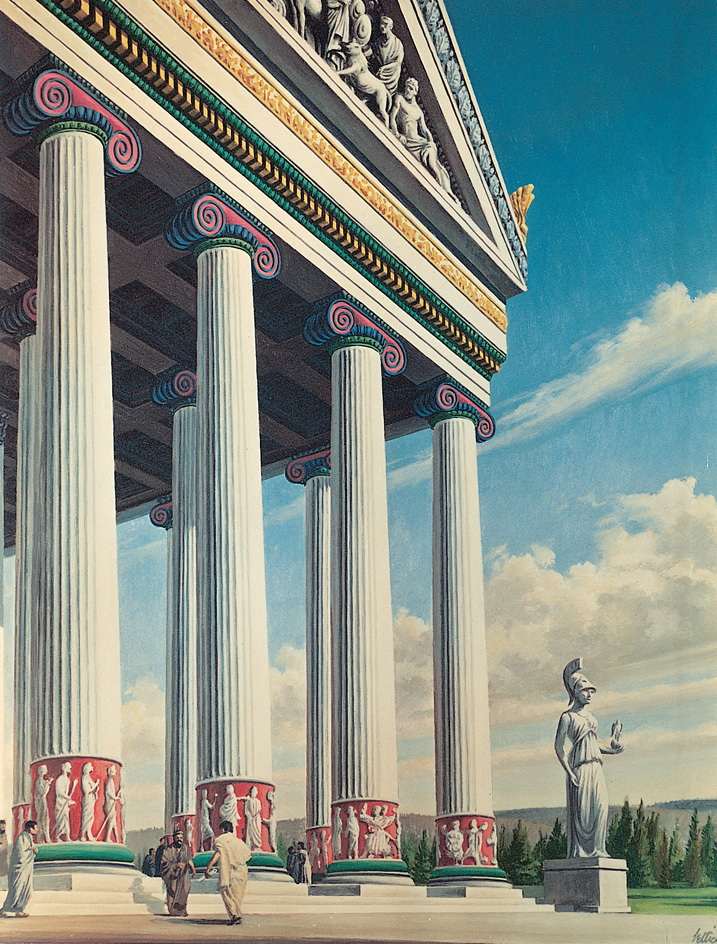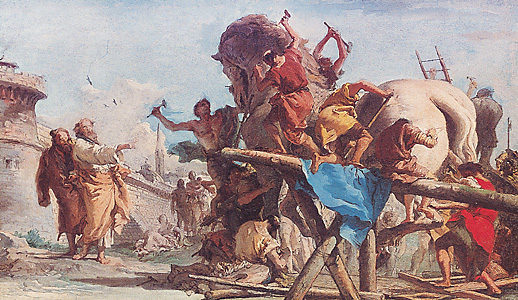Greek mythology is a body of stories developed in and associated with ancient Greece. Greek myths feature some of the best known gods, goddesses, heroes, and stories ever recounted. This article includes a basic overview of Greek mythology, along with links to articles on many of these figures. For much more information on mythology, including the role mythology played in the lives of the ancient Greeks and in other ancient cultures, see Mythology.
The earliest record of Greek mythology comes from clay tablets dating back to the Mycenaean civilization, which reached its peak between 1400 and 1200 B.C. This civilization consisted of several cities in Greece, including Mycenae. The clay tablets describe Poseidon as the chief Mycenaean god. Poseidon later reappeared as a major figure in Greek mythology. The god Zeus, who would become the chief god in Greek mythology, played a lesser part in Mycenaean myths.

About 1200 B.C., the Mycenaean civilization fell. In the 1100’s B.C., Dorians from northwestern Greece moved into lands that had been held by the Mycenaeans. In the next 400 years, the Dorian and Mycenaean mythologies combined, helping form classical Greek mythology.
The basic sources for classical Greek mythology are three works that date from about the 700’s B.C.: the Theogony by Hesiod and the Iliad and the Odyssey, attributed to Homer. Hesiod and Homer rank among the greatest poets of ancient Greece. The Theogony and the Iliad and Odyssey include most of the basic characters and themes of Greek mythology.
The Greek creation myth.
The Theogony includes the most important Greek myth—the myth that describes the origin and history of the gods. According to the Theogony, the universe began in a state of emptiness called Chaos. The divinity Gaea << JEE uh >>, or Earth, arose out of Chaos. She immediately gave birth to Uranus, who became king of the sky. Gaea mated with Uranus, producing children who were called the Titans.
Fearing his children, Uranus confined them within the huge body of Gaea. Gaea resented the imprisonment of her children. With Cronus, the youngest Titan, she plotted revenge. Using a sickle provided by Gaea, Cronus attacked Uranus and castrated him—that is, removed his sex organs. Cronus then freed the Titans from inside Gaea and became king of the gods. During his reign, the work of creating the world continued. Thousands of divinities were born, including the gods or goddesses of death, night, the rivers, and sleep.
Cronus married his sister Rhea, who bore him three daughters and three sons. But Cronus feared that he, like Uranus, would be deposed by his children. He therefore swallowed his first five children as soon as they were born. To save her sixth child, Zeus, Rhea tricked Cronus into swallowing a stone wrapped in baby clothes. Rhea then hid the infant on the island of Crete. After Zeus grew up, he returned to challenge his father. He tricked Cronus into drinking a substance that made him vomit his children. The children had grown into adults while inside their father. Zeus then led his brothers and sisters in a war against Cronus and the other Titans. This war, called the Titanomachy, lasted 10 years. Zeus and his followers finally won the war. They exiled the Titans in chains to Tartarus, a dark region deep within the earth.
The victorious gods and goddesses chose Zeus as their ruler and agreed to live with him on Mount Olympus. The divinities who lived on Olympus became known as Olympians. Gaea, upset that her grandchildren had imprisoned her children, sent an army of giants and monsters to battle the Olympians. In a fierce war called the Gigantomachy, Zeus defeated the giants with the help of his brothers, his sisters, and many of his children.
Greek divinities

Three important gods became associated with the 12 Olympians. They were Hades, ruler of the underworld and brother of Zeus; Dionysus, god of wine and wild behavior; and Pan, god of the forest and pastures.
There were several groups of minor divinities in Greek mythology. Beautiful lesser goddesses called nymphs guarded various parts of nature. Nymphs called Dryads lived in the forest, and nymphs called Nereids lived in the sea. Three goddesses called Fates controlled the destiny of everyone. The Muses were nine goddesses of various arts and sciences. All these divinities became the subjects of specific myths and folk tales.

Greek mythology also has a number of partly mortal, partly divine beings called demigods. Heracles (called Hercules by the Romans) probably ranked as the most important demigod. Heracles symbolized strength and physical endurance. Another demigod, Orpheus, became known for his beautiful singing.
Nearly all the Greek gods, goddesses, demigods, and other divinities became the subjects of cults. Many cults became associated with cities. People of Delphi especially worshiped Apollo. The city became famous for its oracle (prophet). People of Athens looked to Athena as their protector. Ephesus became the center of the cult of Artemis. The Temple of Artemis in Ephesus was one of the Seven Wonders of the Ancient World (see Seven Wonders of the Ancient World).

Greek heroes
became almost as important as the divinities in Greek mythology. Heroes were largely or entirely mortal. They were born, grew old, and died. But they still associated with the divinities. Many heroes claimed gods as their ancestors.
Most Greek heroes and heroines can be divided into two main groups. The first group came before the Trojan War, and the second group fought in the war.
The most famous heroes before the Trojan War include Jason, Theseus, and Oedipus. Jason led a band of heroes called the Argonauts on a search for the fabulous Golden Fleece, the pure gold wool of a sacred ram. Theseus killed the Minotaur, a monster with the body of a man and the head of a bull. Oedipus, the king of Thebes, unknowingly killed his father and married his mother. Oedipus’s story has been popular with artists and writers for more than 2,000 years.

The Greek heroes in the Trojan War included Agamemnon, the commander in chief; Menelaus, Helen’s husband; and Odysseus (Ulysses in Latin), the clever general whose plan finally led to Troy’s defeat. Achilles was the most famous Greek warrior, and the major Trojan heroes were Hector and Paris. The gods and goddesses participated in the war almost as much as the heroes. Nearly all the divinities sided with the Greeks. The major exception was the goddess of love, Aphrodite.
